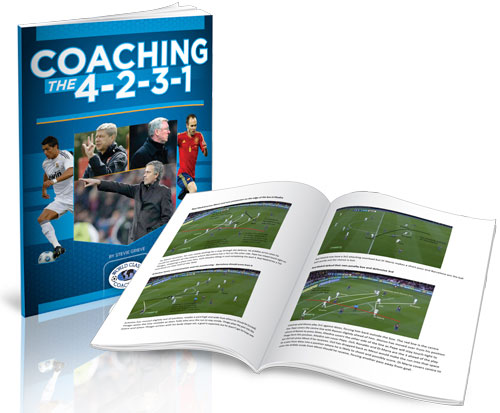By Stevie Grieve, Author of Coaching the 4-2-3-1, Modern Soccer Tactics and Winning Soccer Tactics.
In the recent UEFA CL match between Barcelona and Spartak Moscow, many people expected a close match between the sides, mainly as not only are Spartak a good side, but have ex-Valencia manager Unai Emery as manager, who knows how to play against Barcelona and keep the game tight, as he did so many times with Valencia. Despite never winning against Barcelona, his team was never embarrassed and often looked like they could win, but could never take the chances.
Spartak played the game with a solid and narrow 4-4-2 formation, with Ari and Emeneke looking to play in the channels in transition, Emeneke looking to overpower Mascherano at every opportunity. Barcelona played in their usual style and had most of the possession, looking especially dangerous down the left with Tello v Kombarov, where the 1st goal came from.
Tello goal – Adriano’s deep supporting run creates Tello’s space to shoot.
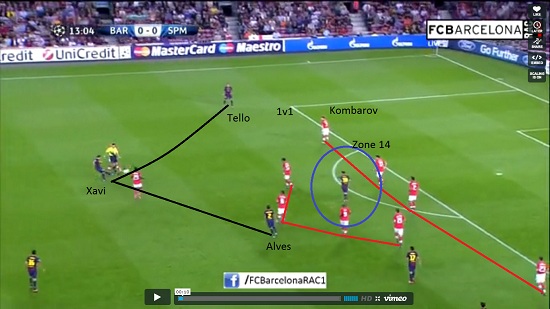
As Alves receives from Pedro, he dribbles inside, and then as he is pressed, passes over to Xavi, who knows he will be pressed and makes a clever 1st time pass into the space for Tello, who have a 1v1 against Kombarov. Spartak have made a good defensive shape to protect zone 14, which is statistically UEFA’s most dangerous scoring area, and also the zone Messi plays inside. They have 6 players all within 5 yards of Messi, forcing passes wide, or into him where multiple players can pressure him and the ball.
Adriano’s overlapping run from deep allows Tello to cut inside and shoot
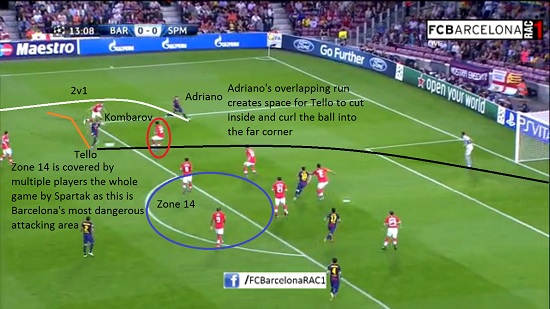
As Tello receives the ball, an Adriano sprint forward from deep provides a 2v1 against Kombarov. Tello cut inside and normally the player circled would pressure the ball, but Adriano’s run behind him offers a pass into the box, so he stalls, allowing Tello space to curl an excellent shot into the far corner for 1-0 Barcelona.
Spartak Counter Attack – Romulo’s late run allows a final pass to score.
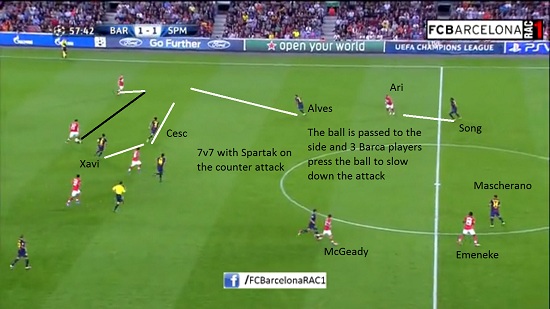
As Spartak pass the ball from the penalty box into midfield, they have a 7v7, with both strikers Ari and Emeneke playing 1v1 with the centre backs – Song is playing centre back instead of Pique who went off injured. Ari drops deep and Song follows.
As the ball is passed wide, Alves takes a gamble to slow down the attack and presses the ball with Cesc and Xavi. If they stop the pass into Ari this is fine, but Alves should stay and cover the space infront of Ari. Romulo is the player closest to the referee, his run will be unmarked.
Ari draws in Song to exploit the space for a pass into the channel
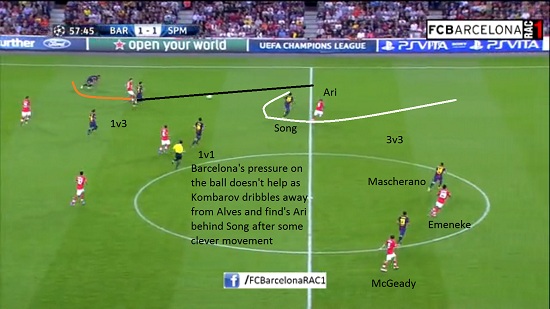
As Barcelona press the ball, Kombarov finds a way through and away from Alves to make the pass forward. Ari has made some clever movements and has been able to lose Song and offer a pass behind the Barcelona defence, making a 3v3 with Romulo unmarked well behind the play.
McGeady’s run from deep offers central options to develop the attack
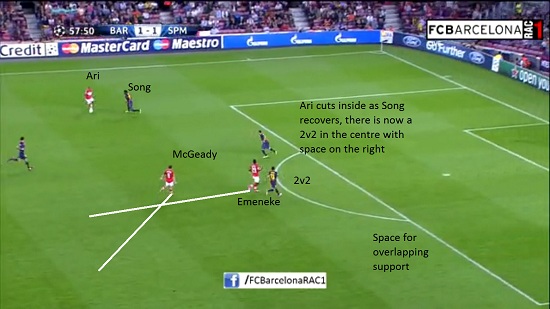
As Ari receives behind Song – he made a clever drop in and spin movement which drew out Song and allowed a pass down the channel. Song recovers but Ari knows to cut inside, as McGeady and Emeneke both fill in the central positions, making a 2v2. McGeady is alone in a dangerous area.
Romulo’s support run allows McGeady to play the final pass for 2-1 Spartak Moscow
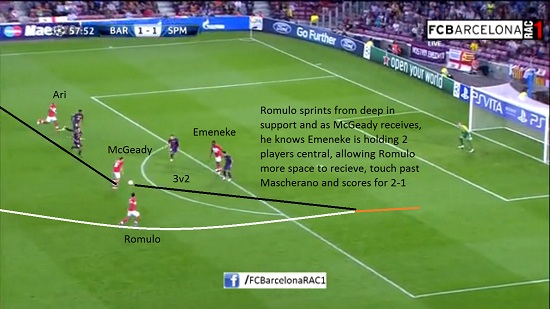
As Romulo sprints forward from deep unmarked, he has stayed wide to offer an outball. McGeady has had a look early and knows to weight the pass for Romulo, who takes his 1st touch ahead of Mascherano and scored for 2-1 Spartak Moscow.
Training Session to develop deep supporting runs
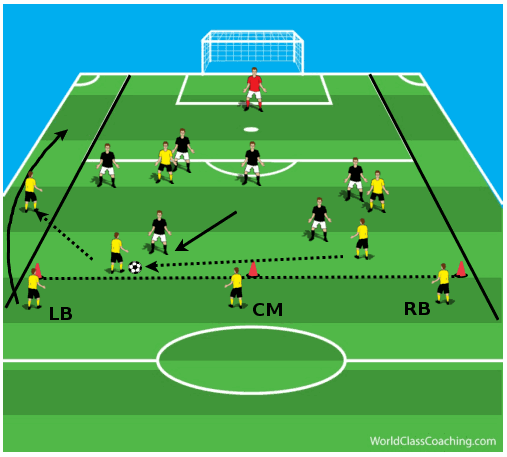
A 4-2 defence plays against a 2-3 attack, with the 2 wide attackers able to move into the wide zone without being pressed before they receive the ball. 40 yards from goal, there is a line where 3 supporting players must start their support runs from behind – the LB and RB can only support in the wide zone, the CM can only move into the central zone, and only when the ball has been passed into that zone from another (for example, above, the LB will overlap when the ball is played from centre to wide, making a 2v1, if the ball was passed back inside, the CM could offer inside the central zone and the LB would have to sprint back into the deep position).
Coaching Points:
- Time the runs to support from deep
- Support at pace
- Support into spaces that need filled to create passing options, overloads or to make space.
- If the ball is transferred into a new zone, return to position quickly as in transition in a match
Progressions/Variations:
- Play against different defensive formations i.e. 3-4, 4-3, 4-4, 5-3 up to 5-4.
- Allow 2 players to support against more overloaded defensive shapes
- Add in a goal and a 2v2 for a counter attack (4-4-2 example)
By Stevie Grieve, Author of Coaching the 4-2-3-1, Modern Soccer Tactics and Winning Soccer Tactics.
